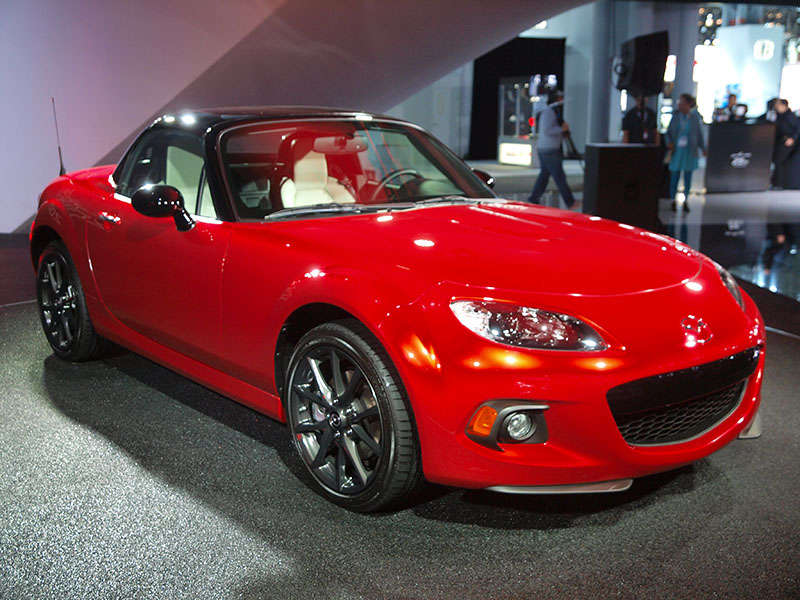Recent Articles
Popular Makes
Body Types
Mazda MX-5 Miata 25th Anniversary Retrospective
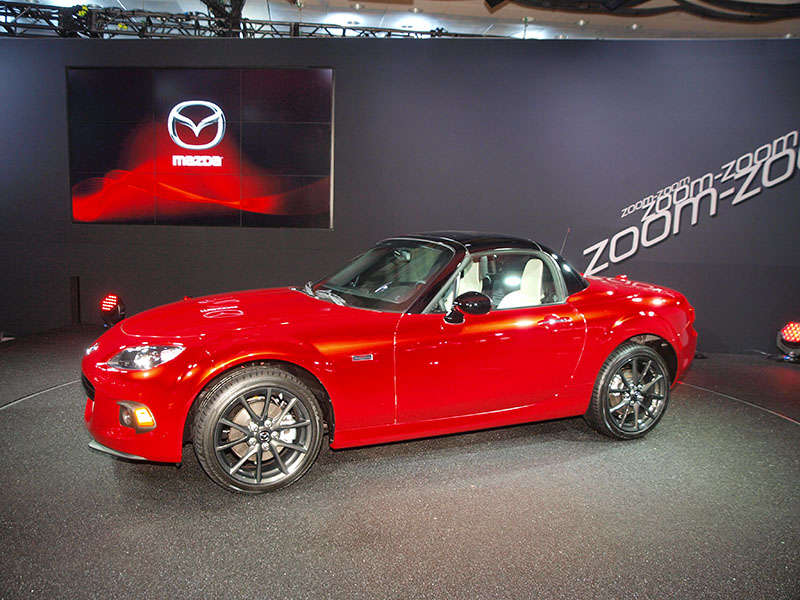
Many accolades have been heaped upon Mazda’s diminutive roadster over the past 25 years. Practically every automotive magazine extant has named it one of its 10 Best, All Stars, Cars of The Year, etc., etc., etc. Remarkably, what seems like such a simple idea, was all but extinct by 1989, when the Mazda MX-5 Miata was unveiled at the Chicago Auto Show on a blustery February day 25 years ago. And while the weather outside may have been cold, the car introduced that day would set the automotive world on fire.
The little Mazda became a bona fide mainstream hit.
For reasons having absolutely nothing to do with the MX-5’s dynamic prowess, the petite roadster became the “it” car of the early 1990’s. And yes, Mazda dealers absolutely had a field day with the demand created by the adorable drop-top two-seater. With a base price of $14,000, the Mazda was seemingly affordable to practically everyone who wanted one. We say seemingly, because dealers recognized what they had on their hands and applied “marketplace adjustment” pricing to the two-seater. And still, demand continued unabated. In fact, demand was so strong; many dealers were actually doubling the sticker price of the Miata. In fact, there is probably someone out there who is still upside down in a first generation Miata.
It really did seem as though every young (or young at heart) blond woman on the planet was clamoring to own one of the cute little cars. Awakened by the success of the Miata among mainstream buyers, owing to its “cuteness”, a host of “cute” cars followed the Miata to market—each of them finding considerable success in their own right. These included the Volkswagen New Beetle, the MINI Cooper, and the reborn Fiat 500.
And, while popular culture got its next new must-have fashion accessory, people who genuinely love to drive got a driving enthusiast’s dream come true. A contemporary recreation of the small British sports cars from the fifties, sixties, and seventies, the Miata was at once nostalgic, and yet completely fresh. The Mazda MX-5 offered all of the delightful fun of wind in your hair motoring, outstanding handling, and terrific responsiveness, without the mechanical maladies routinely plaguing those old British roadsters.
Mazda MX-5 Miata 25th Anniversary Retrospective: The MX-5 Origin Story
Legend has it the Miata came about because of a 1976 conversation between Bob Hall (who was then an automotive journalist), and Kenichi Yamato and Gai Arai (the two of whom worked at Mazda). Hall put forth the idea of building a small inexpensive two-seat roadster in the vein of the classic British sports cars from Triumph and MG. By 1981 Hall was working in product planning at Mazda, and Yamamoto was chairman of Mazda. The conversation about the roadster came up again between the two, and in 1982, Hall was given the go ahead by Yamamoto to look into developing such a car.
Meanwhile, Mazda had recently opened a design studio in California where Hall hired Mark Jordan to work as a designer. The two worked together to establish the overall look and feel of the new Mazda sports car. Despite Hall’s personal involvement however, it was decided Mazda’s Japanese design studio and the California design studio would compete to develop a concept car from which the production version would evolve.
The Tokyo team came up with two ideas, one a front-engine/front-drive concept, and the other a mid-engine/rear-drive concept. The California team stuck with the original front-engine/rear-drive idea. Ultimately, it was decided front-drive wouldn’t provide the driving feel they were looking for, and the mid-engine concept would be too costly by the time they worked all of the kinks out of it. Ultimately, the California proposal became the progenitor of the car we know today.
Taking many of its cues from the England’s Lotus Elan of the 1960’s, Mazda’s prototype Miata was also built in England. With a fiberglass body and mechanicals from existing Mazda models, the prototype was assembled and brought to the United States for evaluation in 1985. The response to the prototype was favorable and production was green-lighted in January of 1986. Three years later, the nomenclature MX-5 was applied to the car (Mazda Experiment Project Number Five). While there is considerable controversy surrounding the origins of the name Miata, it is generally accepted the word comes from a German word meaning “reward”.
The guiding philosophy underpinning the Miata was the idea of a rider and a horse functioning as one entity; "Jinba-Ittai" (horse and rider as one). The goal was to create the ideal driver’s car. To accomplish this, five key parameters were established, which continue to guide the nature of the Mazda sports car to this day.
1. The car should be as light as possible while meeting any safety standards imposed upon it.
2. The interior should be capable of comfortably accommodating two full-size adults with no wasted space.
3. A front-midship/rear-wheel drive layout (engine placed behind the centerline of the front wheels, but ahead of the driver) would always be employed to ensure 50:50 weight distribution.
4. Multi-link suspension systems would always be employed to ensure optimal handling.
5. The engine would be connected directly to the differential to ensure a rigid structure.
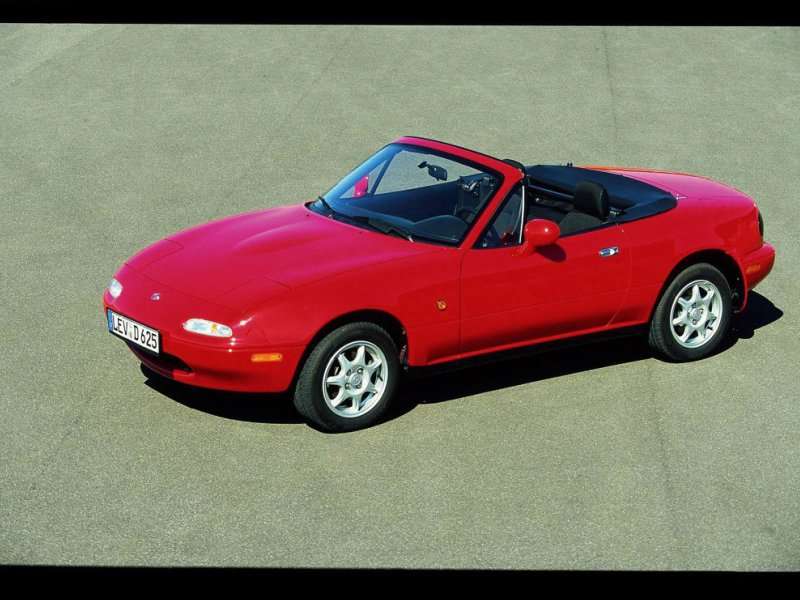
Mazda MX-5 Miata 25th Anniversary Retrospective: MX-5 NA 1989 - 1997
The first generation of the Mazda MX-5 (referred to by Mazda internally as the NA) sold in excess of 400,000 copies. Powering that first Miata was a 1.6-liter double overhead cam inline four-cylinder engine producing 115 horsepower and 100 ft-lbs of torque. The free winding fuel injected powerplant was mated to a short-throw five-speed manual transmission and rear-wheel drive as standard equipment. A four-speed automatic was offered as an option, but it found few takers, as it really hampered the performance of the car.
While 115 horsepower and 100 ft-lbs of torque sound relatively paltry, it is important to remember curb weight of that first Miata was a mere 2,050 pounds. Of course, we’ll freely admit that first Miata wasn’t a fast car. The beauty of the MX-5 lies in the idea it is more fun to drive a slow car fast. In other words, you could freely enjoy flinging the little roadster into corners, exploiting its 50:50 weight distribution, all the while intentionally inflicting oversteer and catching it, but at speeds that wouldn’t result in a mile long debris field if something went awry.
The1989 Miata’s zero to 60 time was quoted at just over eight seconds and top speed was said to be 126 miles per hour. A number of limited edition models were produced during the first five years of the MX-5, one of the most notable being clothed in British racing green and outfitted with a beige leather interior.
The first refresh of the Miata came in 1994, when a more powerful engine was introduced. Now boasting 131 horsepower and more standard equipment, which meant more weight, the Miata’s performance potential improved only marginally. Output was again improved in 1996—to 133 horsepower.
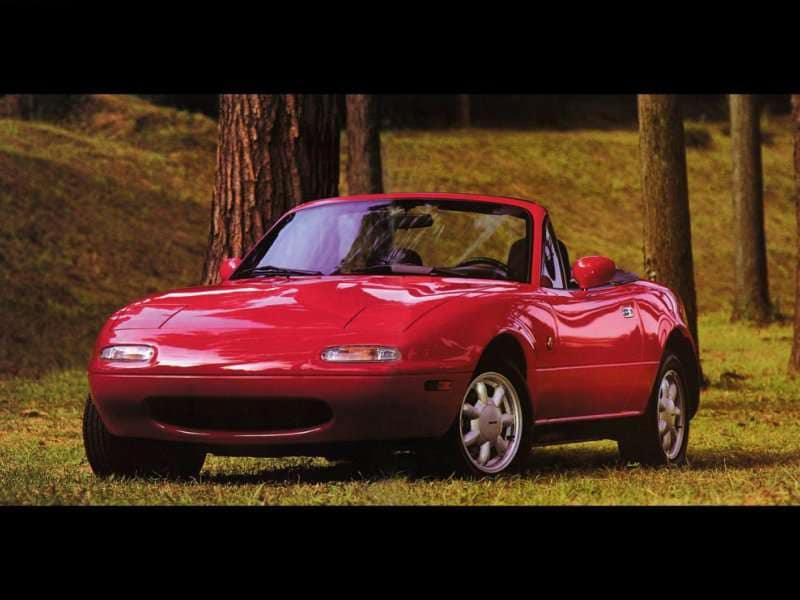
Mazda MX-5 Miata 25th Anniversary Retrospective: MX-5 NB 1997 - 2005
The second generation of the MX-5 bowed in 1997 at the Tokyo Motor Show. The car went on sale in 1998, as a 1999 model. The first generation car’s pop-up headlights and Lotus-inspired air intake gave way to styling cues derived from the 1995 Mazda RX-7 to introduce some familial resemblance to the Mazda sports car lineup. Also predicating the change was the fact the popup headlights would no longer pass the then-new pedestrian safety regulations. Base price increased from $13,995 to $19,770 (which was about the same as the base price of the Mazda RX-7 back in 1989 when the Miata was introduced).
Dimensions were slightly larger all around, and the curb weight of the basic car increased to 2,300 pounds. In keeping with the tenets established for the original car, the independent suspension system was maintained, albeit enhanced to take advantage of the developments in suspension systems since the introduction of the original car. Wheels, tires and brakes were also upgraded, and ABS was offered as an option.
Displacement was increased to 1.8-liters and output was commensurately increased to 140 horsepower and 116 ft-lbs of torque. A variable intake manifold was employed to improve the engine’s breathing ability. The 1999 Miata claimed a zero to 60 of 7.6 seconds and a top speed of 130 miles per hour.
A Tenth Anniversary Edition was offered featuring a six-speed manual transmission, Bilstein shocks, and a top speed of 133 miles per hour. Painted sapphire blue mica, the Tenth Anniversary MX-5 featured two-tone blue and black leather and Alacantara seats.
For the 2001 model year, the MX-5 got a model refresh. Fog lights were made standard equipment, the instruments got white faces with red numbers, and the seats were reworked with deeper bolsters and a taller headrest. The suspension system was upgraded and the body was strengthened to improve rigidity. As a result, curb weight increased, with a lightly optioned model coming in at 2,348 pounds. To offset the weight increase, engine output was bumped to 143 horsepower.
In 2004, Mazda’s in-house tuning team was given an opportunity to exercise its ambitions upon the Miata, with the result being called the Mazdaspeed MX-5. By applying turbocharging to the Miata’s engine, the Mazdaspeed team coaxed 180 horsepower from the powerplant. The suspension system, brakes, transmission, and clutch were upgraded to cope with the Mazda’s additional power output. The Mazdaspeed MX-5’s zero to 60 was quoted at 6.2 seconds, but top speed was limited to 126 miles per hour.
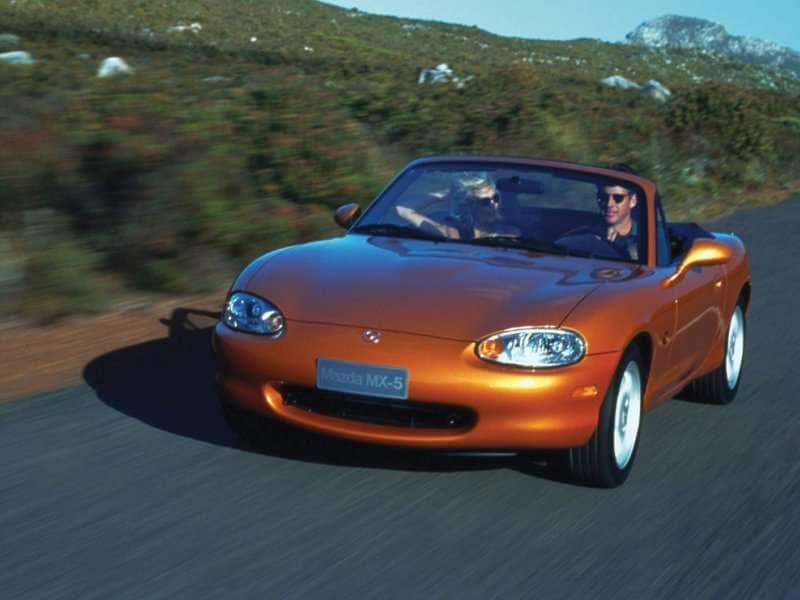
Mazda MX-5 Miata 25th Anniversary Retrospective: MX-5 NC 2005 – 2014
By the end of the run of the second generation of the Miata, the fervor had cooled somewhat for the Mazda sports car. In the interim years, buoyed by the success of the roadster, a number of competitors had appeared. It can be argued quite convincingly the existence of the Honda S2000, Mercedes-Benz SLK, BMW Z3/Z4, and to a degree, the Porsche Boxster, were informed by the accomplishments of Mazda with the Miata.
While the original’s popup headlights remained firmly lodged in the model’s past, many of the other styling cues of this third generation Miata recalled the original; most obviously the oblong front air intake. The suspension system was once again revised, and engine displacement was increased to 2.0-liters. This, of course, also entailed a power increase to 170 horsepower and 140 ft-lbs of torque. Both five and six-speed manual transmissions were offered—as well as a six-speed automatic. If the automatic was fitted power output was decreased to 158 horsepower. The six-speed manual transmission setup also included a limited–slip differential.
Lightly optioned, curb weight came in at 2,447 pounds.
The NC MX-5 also marked the first appearance of the power retractable hardtop option for the Miata. Designed to fold away beneath a hard tonneau cover, the hard top fit into the same well as the folding soft top, so it did not diminish the MX-5’s trunk capacity. The roof could be retracted or deployed in 20 seconds. This power retractable hard top version of the Mazda sports car was first offered during the 2006 model year.
The first update of the NC was shown in 2008, at the Paris Motor Show. Mazda’s now current grille treatment was applied, along with new headlights and taillights. The interior of the Mazda was reworked a bit to improve cabin space and the instrument panel was mildly reworked as well. On the mechanical front, the suspension system was revised to improve handling, and the gearbox was recalibrated to smooth shifts.
The 25th Anniversary Edition of the Mazda MX-5 Miata was unveiled at the New York Auto Show on April 16, 2014. Employing the power retractable hard top, the car is offered in a Soul Red Metallic paint job. Key distinguishing features include a black roof, A-pillars, and exterior rear view mirror housings. The interior features off-white leather upholstery and door trim.
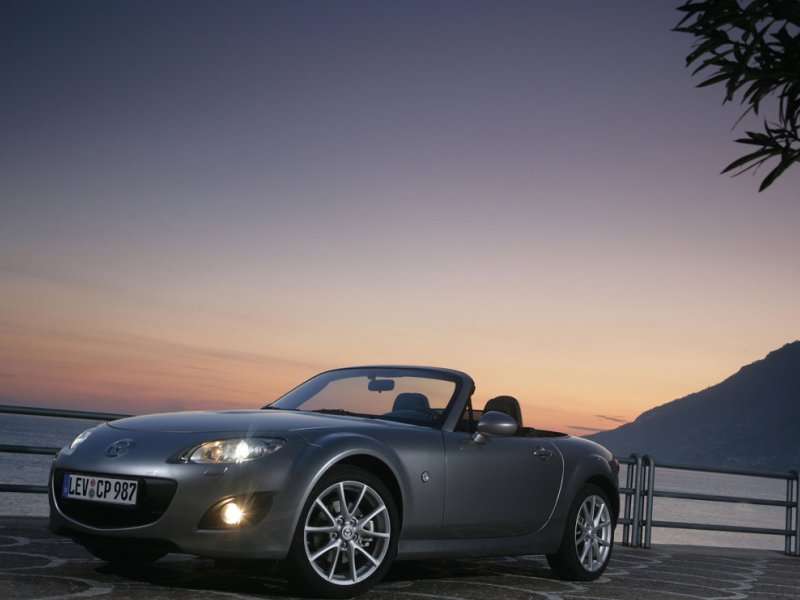
Mazda MX-5 Miata 25th Anniversary Retrospective: MX-5 ND—2015-
It has recently been announced Mazda and Fiat will co-operate on the development of the next generation Miata. Alfa Romeo will share the underpinnings of the next version of the MX-5 for a small roadster as well. At the 2014 New York Show the company showed the chassis of the ND MX-5.
The most compact powertrain configuration yet for the Miata, the engine will be located more centrally and the center of gravity will be lowered. While both cars will be manufactured in Japan, the Alfa will have its own unique engines and other styling elements.
The Guinness Book of World Records has declared the Mazda Miata to be the best selling two-seat sports car in history, with production in excess of 500,000 units as of 2000. By 2011, this number had reached 900,000. Without question, the Miata is certainly one of the most beloved cars ever created—and one of the most fun to drive.
